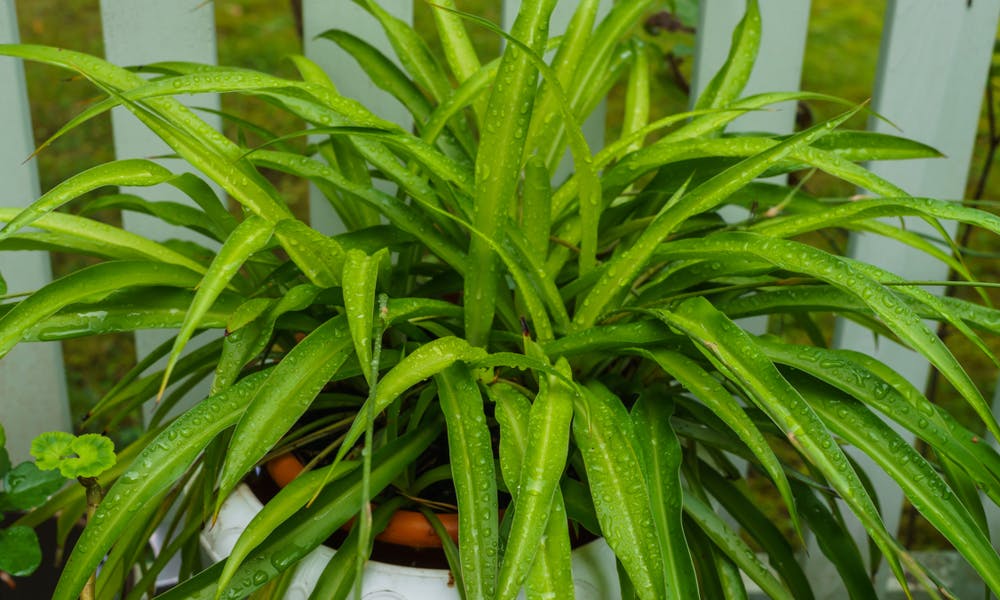The spider plant is a very popular, easy-to-care indoor plant, that can be adapted to many environments because it is not demanding. If you want to go on vacation for two or three weeks, the plant lasts without water. It is a beautiful plant that fills your home with freshness, with small and beautiful blooms that certainly add color to your home decor. In this article, you can read about:
* The history and general presentation of spider plant
* Types of spider plants
* How to grow and how to care for the spider plant
The History and General Presentation of Spider Plant
The spider plant (Chlorophytum comosum) is an indoor plant, very adaptable and got its name from the spider plant babies that resembled the bodies of some spiders. Spider plants bloom in the summer. The flowers are small, white, and the leaves are glossy, narrow, like green grass, and slightly lighter towards the middle of the leaf. The leaves grow very long and give a “shaggy” or “weeping” appearance to the plant that looks magnificent in a jar hanging on the walls of your house.
These plants are native to South Africa and, since the 19th century, the plants have spread throughout the world. Researchers discovered that spider plants are very beneficial for the inside of our homes because they are purifying the air, eliminating as much as 90% of the toxic substances. It is also valuable for our health because it helps improve mental health. Cleaner air is associated with less stress and more relaxation, so we can sleep better at night and pursue our activities with more positivity.
Types of Spider Plants
There are over 65 varieties of spider plants. The most popular ones include:
* Chlorophytum Laxum (Zebra Plant). This variety differs from the other varieties because the leaves have a much brighter yellow outline on the leaves.
* Chlorophytum Comosum “Variegatum” (Aircraft Plant) This variety of spider plant is the most common of all spider plants. The middle of each leaf is light yellow, while the outline is forest green. This variety is the best variety for air purification in the room and has a fantastic look.
* Chlorophytum Comosum “Revers Variegatum” (Reverse spider plant) As the name suggests, the outline and middle of the leaves are reversed, compared to the other varieties. This means that the outline of the leaves is pale yellow, while the middle of the leaves is green forest. These plants grow quite tall.
* Chlorophytum Comosum (Bonnie plant) These spider plants are distinguished, from the other species, by their leaves that are not straight, similar to grass. Rather, they are wavy, curly, and also these plants are quite rare compared to the other varieties.
How to Grow and How to Care for Spider Plant
To grow well, your plant needs a suitable pot that has high water drainage capacity and is large enough for the roots to grow. Thus, for this reason, clay pots are not exactly suitable, because there is a danger of cracking when the roots of the plant develop. For a young plant, the pot can have a diameter of 4 to 6 inches.
The suitable soil for spider plants is the one with high drainage capacity, not the one with fluoride fertilizers that is harmful to plants. The most suitable soil is an organic mixture of compost, peat, sludge, and granular sand.
In the growing months, these plants need a lot of water. With the coming of the cold season, the plant needs less water. You should be careful regarding the quantity of water you give to your plant. You should water the plant abundantly once and then leave it for some period so that the soil dries and only when it is sufficiently dried you should again water the plant. So, in this way, you avoid root rot, as they tend to retain water.
You should be careful with the water you give to your plant because tap water can contain fluoride, which is harmful to the plant. The most suitable type for watering is distilled water. As a tip, if you have an aquarium in your house, water the spider plant with some aquarium water from time to time.
Spider plants can be grown from seeds. After the flowering period when the flowers die, fruits appear. These fruits are like green pods and contain seeds. You can only harvest the seeds when these pods are completely dry. As a secret, the moment you see that the pods have appeared, put the pot on a piece of paper. When the seeds are ready and dry, they fall on the piece of paper and you can easily retrieve them.
The seeds are small, flat and black. The seeds should be planted for about 1/2 inch deep in the organic soil mix. The seeds develop the spiderettes (baby spider plants). They require extra care because they are very fragile. These seedlings should not be moved from their places until they have at least three or four leaves.
After they formed their roots, they can be planted in the soil. They develop very well if they have plenty of water and sunlight. Spider plants do not like the cold season and do not withstand frost, so it is better to plant them in pots. This way, you can keep them outside during summer and move them inside when the cold weather approaches. You should be careful not to over-fertilize your plant because the leaves get a brown color. The same color can appear on the leaves if the plant is watered excessively.
All in all, spider plants adapt quickly to any environment and are the ideal plants for the interior of your home or to bring you a note of extraordinary freshness in your office.
